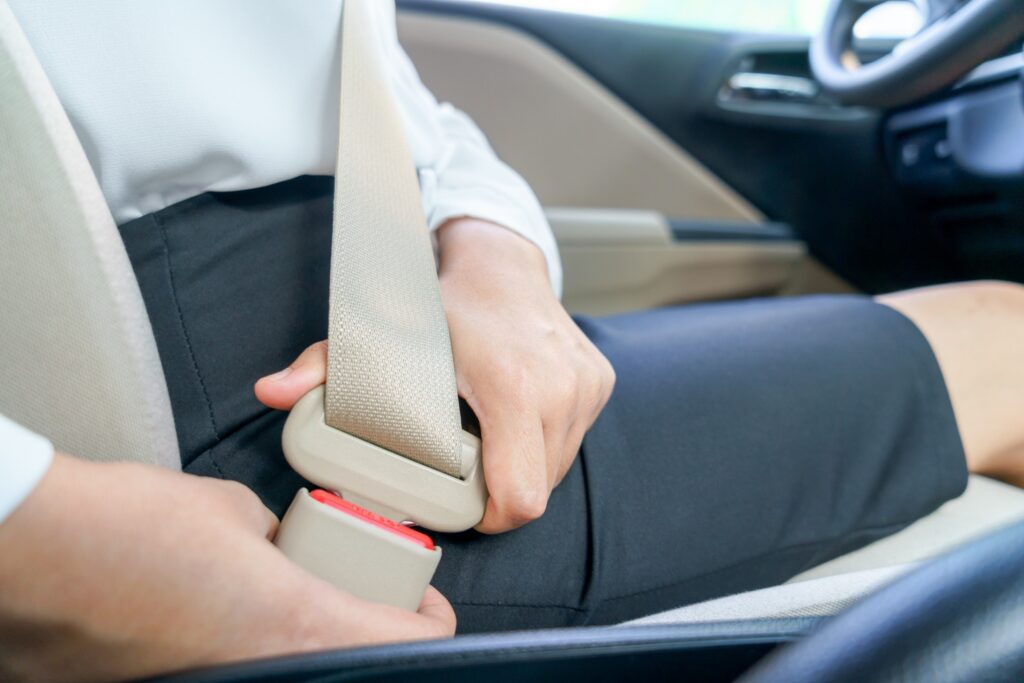
To say there’s a lot of misinformation about seat belt safety would be an understatement. A considerable portion of the population still believes that seat belts don’t make a difference in the event of a car accident. In fact, the National Highway Traffic Safety Administration (NHTSA) estimates as many as 8.1% of vehicle occupants in 2023 did not wear seat belts. That number is distressing, considering that it’s well documented that seat belts can literally save lives in the event of a car accident.
At Lerner and Rowe Injury Attorneys, we’ve seen firsthand the impact that wearing a seat belt or (not wearing one) can have on a person’s life. A seat belt can mean the difference between minor and catastrophic injuries; not wearing one can mean losing your life in what should have been a survivable crash. To help spread information, our personal injury lawyers debunk five of the most common seat belt safety myths.
MYTH: Seat Belts Will Trap You Inside a Burning or Submerged Vehicle
One of the most pervasive myths regarding seat belts is that they will trap you inside your car if you’re in a car accident. In crashes that result in a vehicle being submerged in water or catching fire, this is an understandable concern. Some may even say they’d rather take their chances on more serious car wreck injuries if it means avoiding death by drowning or severe burns.
In reality, while it is possible for a seat belt’s release mechanism to malfunction after an accident, it’s not likely. Not only that, but deaths from vehicle fires and submersion are comparatively rare. The NHTSA estimates that there are around 384 traffic fatalities involving accidental drowning per year, while the National Fire Protection Association (NFPA) estimates that 643 civilians die in vehicle fires annually. To put that into context, 40,990 people died in fatal motor vehicle accidents in 2023 according to preliminary data from the NHTSA.
Compare that to the 14,955 lives that were saved in 2017 because of wearing a seat belt, or the additional 2,549 lives that could have been saved had everyone buckled up and the answer is clear—not only do seat belts save lives, but they also reduce your risk of moderate to critical injury by 50% when worn in the front passenger seat.
Another thing to consider about vehicle fires and submersions is this: you are far more likely to be knocked unconscious or otherwise severely injured in an accident without a seat belt on than you are to be trapped by a malfunctioning seat belt—and you have a much better chance of escaping a burning or sinking vehicle if you’re conscious and mobile.
Tip: If you’re worried about getting trapped inside your vehicle by a faulty seat belt, consider investing in a high quality seat belt cutter and/or window breaker. Keep this tool in your driver’s side door, center console, or purse for easy access in case of an emergency.
MYTH: Airbags Mean That You Don’t Need Practice Seat Belt Safety
Airbags work by rapidly inflating during a moderate to severe impact, preventing drivers and passengers from hitting the vehicle interior and sustaining concentrated impact forces. But while airbags are incredibly effective, they are meant to be used in conjunction with seat belts, not as a replacement for proper seat belt safety.
In fact, when someone is not wearing a seat belt, airbags may have the opposite effect. Those who are unrestrained or improperly restrained have a higher risk of suffering spinal injuries or traumatic brain injuries from hitting the airbag. And in high impact crashes, airbags alone aren’t enough to prevent someone from being ejected from a vehicle.
The NHTSA estimates that wearing a seat belt reduces your risk of death in a frontal crash by 50%, and that airbags reduce the risk of death by 34%. Furthermore, when used in conjunction, seat belts and airbags can reduce your risk of death by as much as 61%.
MYTH: Seat Belts Are More Likely to Cause Injuries Than Prevent Them
Seat belts are incredibly effective at keeping people in their seats during an impact or rollover. Still, impact with the seat belt itself can lead to a cluster of injuries often called seat belt syndrome. Seat belt syndrome may include minor injuries like abrasions and bruising to the chest and abdomen or more serious injuries like fractures to the ribs, sternum, or spine. Seat belts may also play a role in some soft-tissue injuries or internal organ damage.
While it is true that seat belts themselves can cause injuries during a car accident, the severity of these injuries usually pales in comparison to the frequently fatal injuries caused by not wearing a seat belt at all—in particular, severe trauma to the head, chest, and abdomen.
MYTH: You Don’t Need to Practice Seat Belt Safety for Short Trips Near Your Home
People tend to let their guard down when they’re in their comfort zone. They don’t pay as much attention to their surroundings, they’re more likely to engage in distracted driving, and they might not put on their seat belt because they’ve safely completed a certain drive dozens or hundreds of times. As a result, about one in three car accidents occur within five miles of home, often when drivers are least expecting it.
One of the most crucial aspects of seat belt safety is consistency. Seat belts should be worn every time you get in your vehicle, whether you’re headed down the street to the grocery store or on a cross-country road trip.
MYTH: You’re Less Likely to Be Injured if You’re Thrown from a Vehicle
Those who question conventional seat belt safety often claim that it’s actually safer to be thrown clear from your car in an accident. This is an extremely misguided and dangerous notion. In reality, ejection from a vehicle is one of the most injurious events that can happen to someone in an accident. Occupants are rarely “thrown clear” from the vehicle. Instead, they are often dragged along the pavement, crushed under their own car, or hit by debris or another vehicle.
As a result, people who are thrown from their vehicle make up a significant portion of people that die in fatal crashes. According to the NHTSA, 22% of the people that died in fatal crashes in 2021 were ejected from a vehicle.
Lerner and Rowe Urges You to Practice Seat Belt Safety
The team at Lerner and Rowe hopes that you found the information above useful. Please use it to reinforce what you already know about seat belt safety and to teach your family about its importance. As part of National Seat Belt Day, we encourage you to share this information with your family and friends, particularly younger drivers that may not know the importance of proper seat belt use.
Unfortunately, some injuries will happen even if you’re wearing a seat belt. If you’ve been injured in a car accident caused by another driver or a defective product then contact us for immediate assistance. You can reach us 24/7 by phone at 844-977-1900 and through the Internet via secure contact form and LiveChat. Consultations are free and you don’t not pay a cent unless monies have been recovered on your behalf.
Lerner and Rowe Injury Attorneys has a proven track record of winning billion-dollar results for injury victims across the nation. Furthermore, our team is committed to helping clients carry the emotional burden of their injuries–a commitment that has helped us earn glowing reviews. One call does it all. A call to Lerner and Rowe may be the most important one you’ll ever make.



